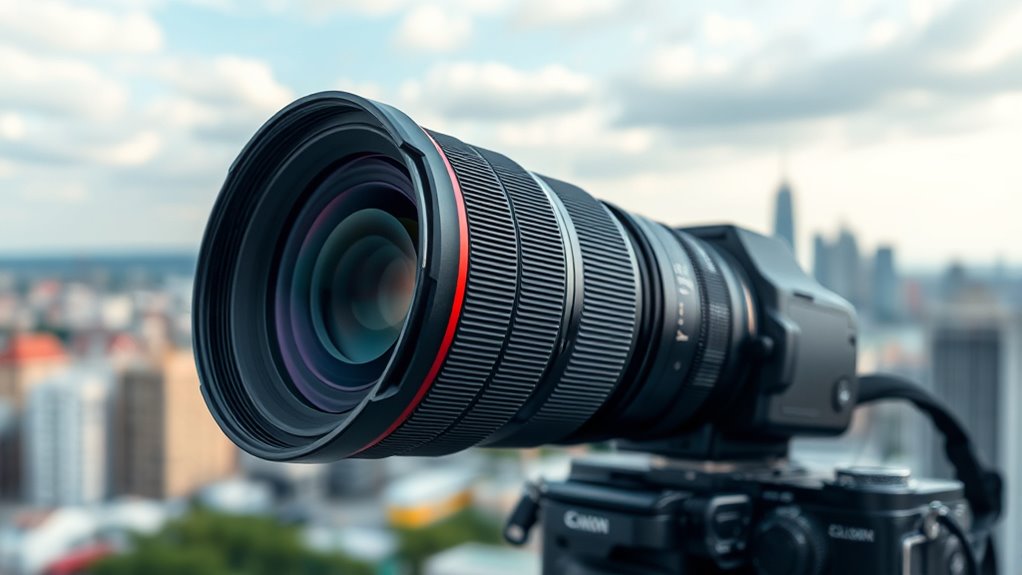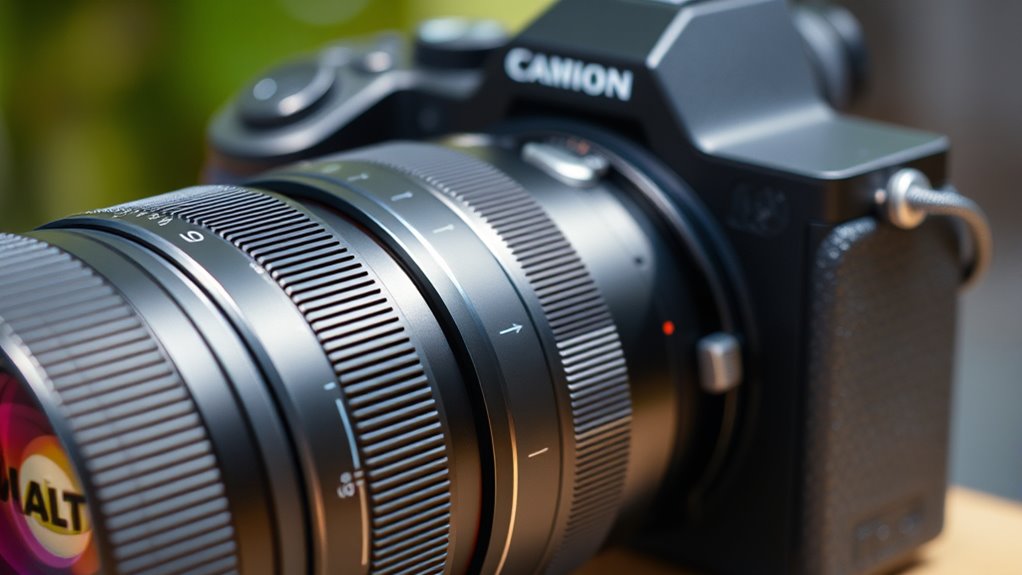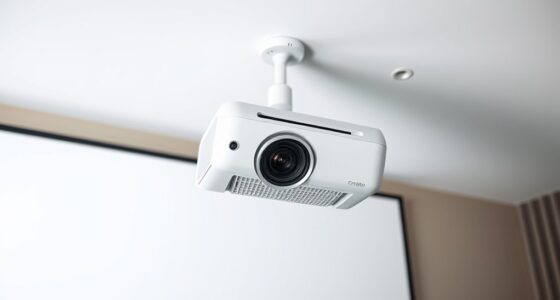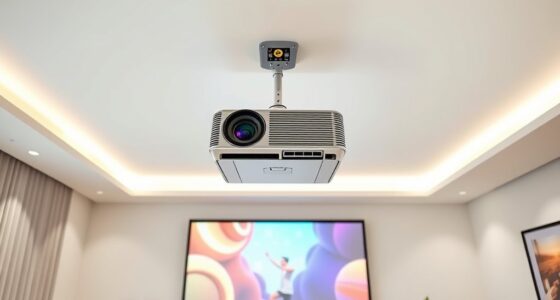A zoom lens with a wide focal range gives you more setup flexibility by letting you quickly switch between wide-angle shots and zoomed-in details without changing lenses. This makes it easier to adapt to different scenes and environments, saving you time and effort. With a versatile zoom lens, you can respond faster to spontaneous moments and creative opportunities. Keep exploring how adjusting your zoom range can elevate your shooting experience and improve your results.
Key Takeaways
- A wider zoom range allows quick adaptation to various scenes without changing lenses, increasing shooting efficiency.
- Greater zoom flexibility enables seamless framing adjustments, reducing time spent on lens swaps during dynamic shoots.
- Extensive zoom ranges support diverse focal lengths, from wide-angle landscapes to close-up portraits, enhancing creative options.
- Broader zoom ranges offer better control over composition and perspective, improving overall setup versatility.
- Increased zoom range facilitates shooting in unpredictable environments, ensuring optimal framing and focus in changing conditions.

Have you ever wondered why zoom lenses are so essential in photography and videography? The answer lies in their incredible flexibility, which primarily stems from their varying focal lengths and aperture versatility. When you use a zoom lens, you’re essentially gaining access to a range of focal lengths within a single lens, allowing you to quickly adapt to different scenes without changing your equipment. This range enables you to capture everything from wide-angle landscapes to close-up portraits, all with a simple twist of the zoom ring. With a lens that offers a broad focal length spectrum, you can maintain a consistent setup and avoid the hassle of swapping lenses, which is especially advantageous in fast-paced shooting environments.
Focal length plays a critical role in how you frame your shots and interpret scenes. A shorter focal length offers a wider field of view, perfect for capturing expansive landscapes or crowded events, while a longer focal length allows you to zoom in on distant subjects with precision. The beauty of a zoom lens is that it grants you the power to seamlessly transition between these perspectives without stopping to change your lens. This adaptability not only saves time but also helps you stay more present and focused on your subject, rather than worrying about equipment changes. Plus, the ability to quickly shift focal lengths means you can better respond to spontaneous moments, which is often key to capturing compelling images or videos.
Seamlessly shift focal lengths to adapt quickly and capture spontaneous, compelling scenes with ease.
Aperture flexibility is another essential aspect of zoom lenses that enhances their importance. Many zoom lenses feature variable apertures, allowing you to open the lens wider at certain focal lengths and narrow it at others. This flexibility means you can control the amount of light entering the camera, giving you greater creative freedom and better performance in different lighting conditions. For example, a wide aperture lets you achieve a shallow depth of field, making your subject stand out against a blurred background, while a narrower aperture keeps more of the scene in focus. When combined with a broad focal length range, aperture flexibility makes zoom lenses versatile tools that adapt to diverse shooting scenarios, from low-light indoor shots to bright outdoor scenes.
Additionally, the influence of sound vibrations on the environment highlights the importance of understanding how different tools and techniques, such as zoom lenses, contribute to capturing high-quality images in various conditions. Ultimately, the significance of a zoom lens comes down to its ability to provide setup flexibility. By offering a wide range of focal lengths and adaptable apertures, zoom lenses empower you to react quickly, experiment creatively, and capture a variety of scenes without interruption. This combination of focal length options and aperture versatility makes them invaluable in both professional and casual photography, helping you to produce high-quality images and videos with ease and efficiency.
Frequently Asked Questions
How Does Zoom Lens Quality Impact Image Clarity?
You’ll notice that high-quality zoom lenses improve image clarity because their lens construction minimizes distortions and aberrations. This guarantees you get sharper images across the zoom range. Cheaper lenses often compromise on construction, leading to softer images and reduced sharpness. Investing in a well-made zoom lens enhances your photo quality by maintaining consistent, clear details from wide-angle to telephoto, making your images crisper and more professional-looking.
Can a Zoom Lens Replace Multiple Fixed Lenses?
Imagine a chameleon blending seamlessly into its surroundings, adapting effortlessly—that’s your zoom lens. It replaces multiple fixed lenses by offering focal length versatility, giving you broad or tight shots without switching gear. While it won’t match the optical quality of specialized lenses in every situation, its lens versatility makes it a practical all-in-one tool, saving time and space while providing the flexibility you need for dynamic shooting scenarios.
What Maintenance Is Required for Zoom Lenses?
You need to regularly maintain your zoom lens by performing lens cleaning to remove dust and smudges, ensuring clear images. Additionally, check and calibrate the lens periodically to maintain ideal focus and zoom functionality. Handle the lens carefully, store it properly, and avoid extreme temperatures. Proper maintenance keeps your zoom lens in top condition, prolonging its lifespan and ensuring consistent performance during your shoots.
How Does Zoom Range Influence Video Recording Options?
Like a chameleon changing colors, your zoom range shapes your video options. A wider focal length gives you more framing flexibility, allowing for dynamic shots, while a narrower zoom restricts your perspective. With a versatile zoom lens, you can effortlessly switch between wide shots and close-ups, making your recording more adaptable to different scenes. This flexibility ensures you capture the perfect moment without changing lenses constantly, saving time and maintaining your creative flow.
Are There Specific Zoom Ranges Better for Wildlife Photography?
For wildlife photography, a zoom range of 70-300mm or 100-400mm works best, offering excellent wildlife focus and zoom versatility. This allows you to capture distant animals without disturbing them while maintaining sharp detail. Longer zooms, like 200-600mm, give you even more reach for elusive creatures. Choose a lens with a versatile zoom range so you can adapt quickly to different wildlife scenarios and get the shots you want.
Conclusion
In the grand universe of photography, a zoom lens with a versatile range isn’t just helpful—it’s your secret weapon against the chaos of unpredictable scenes. Imagine capturing breathtaking shots from the edge of a stadium or zooming in on a tiny detail without ever changing your setup. With the right zoom range, you disclose a superpower that transforms ordinary moments into extraordinary masterpieces—making your photography game unstoppable and your creative vision limitless.









